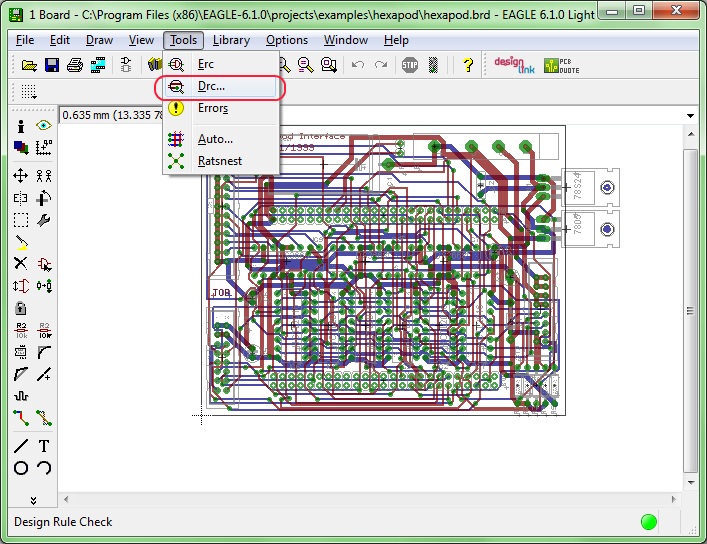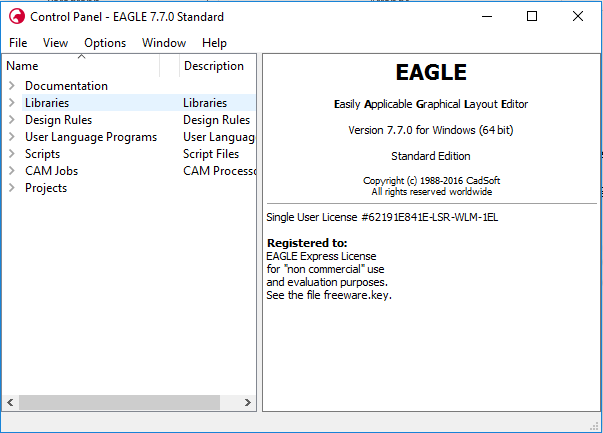This post explains how to create a 3D CAD model from a PCB design from EAGLE. The following versions of the software are used: Eagle 6.6; Solidworks 2014 (with CircuitWorks) Export from Eagle. First, the board outline must be specified in the layer 20 (Dimension). If there is no board outline, add a close shape on layer 20 with the Wire tool. I'm new to Eagle, but find it pretty easy to use and I can create PCBs pretty quickly that my PCB fab in China can make in a few days. I have some PADS (MentorGraphics).sch and.pcb files that I want to import into Eagle. I have searched many forums, visited the CadSoft support page and even asked CadSoft Tech Support, not much success so far. How to open PCB files. If you cannot open the PCB file on your computer - there may be several reasons. The first and most important reason (the most common) is the lack of a suitable software that supports PCB among those that are installed on your device. A very simple way to solve this problem is to find and download the appropriate application. In the Eagle, open Board view. Click the “CAM” button or choose “File-CAM Processor”. This will open the CAM Processor tool that is used to generate the files. Here you can define the sections you want to create files for.
Did your computer fail to open brd file? We explain what brd files are and recommend software that we know can open your brd files.
What is brd file?
A brd file extension is related to EAGLE (short for Easily Applicable Graphical Layout Editor). A brd file stores CAE data about a single PCB (Printed Circuit Board).
brd file description
The brd file extension is associated with EAGLE (short for Easily Applicable Graphical Layout Editor), a CAE program for creating PCB schematics, developed and sold by CadSoft Computer, Inc.
The brd file contains CAE data about a single PCB created and saved in the program. If there is also a .sch file (schematics) with the same file name, both are loaded at once, when a .brd file is opened.
The brd file is also viewable in FreeCAD tool with installed FreeCAD-PCB mod.
Software that will open brd file

EAGLE Layout Editor
High quality PCB design softwareOther brd file extensions
brd - BizInt data transfer file
A brd file extension is related to the BizInt Smart Charts for Drug Pipelines. A format used for transferring data.
brd - Cadence PCB design
A brd file extension is related to PCB design format used by Cadence applications.
brd - KiCad PCB design
Open Pcb File In Eagle County
A brd file extension is related to the KiCAD and used for its PCB design files.
brd - Winning Bridge saved hand data
A brd file extension is related to the Winning Bridge video game. A brd file stores saved hand data.
A quick guide to using and personalizing Eagle configuration script files to tailor settings to your needs.
FavoritedFavorite1Let's talk about Eagle Configuration Scripts: how to use them, and why using your own can make your Eagle experience more enjoyable and efficient.
Let me preface this by saying that there is more I do not know about Autodesk's EAGLE PCB Design Software than there is that I do. That said, this is just a quick explainer, and there will be plenty left unsaid about using Eagle scripts.
If you are new to Eagle or unfamiliar entirely, check out these tutorials to help you get started:
What is a Configuration Script?
Put simply, it's a file used to configure an instance of Eagle with specific settings when opened.
When an instance of an Eagle editor is opened, Eagle accesses a configuration script file (eagle.scr). The configuration script contains a series of commands written in human readable text that change the settings for any instance of an Eagle editor workspace when opened. These include: BOARD Editor, SCHEMATIC Editor, LIBRARY Editor, DEVICE Editor, PACKAGE Editor and SYMBOL Editor. By changing the set of commands within the configuration script, the user can customize the settings of any of the aforementioned Eagle editors without the tedium of having to manually change the settings every time you open up an instance of Eagle.
Perhaps the most valuable feature of a personalized configuration script is the ability to setup a hotkey assignment map and workspace that caters to how you use Eagle. Whether you are designing schematics, designing boards, designing both or just reviewing designs, you can tailor the configuration of Eagle to allow you to work more efficiently.

Eagle is distributed with a default configuration script; it sets some default layers to be used, sets the unit(s) of measure, sets the grid spacing and calls some .ulp files, plus a few more things. Check it out below:
This default Eagle configuration script by no means makes Eagle unusable, but you are stuck with some pretty basic configuration settings. We have a SparkFun Eagle Settings GitHub repository, which includes an Eagle configuration script that provides a good starting point for understanding how these scripts are used, and for personalizing your own.
If you are new to GitHub, below are a couple tutorials explaining what it is, and how it is used:
Below is a simple demo configuration script to use as an example. Let's quickly break down some of the script so that you can get started making or modifying your own!
Anatomy of a Configuration Script
The configuration script is broken into a section for each variation of an Eagle editor, and each type is denoted by an editor-specific label. These labels instruct Eagle to run only the portion of the script that is between the editor type label being opened and the next editor label. This means the user can customize unique configuration settings for each editor type, most importantly hotkeys.
| Editor Type | Editor Label |
| Schematic | SCH: |
| Board | BRD: |
| Library | LBR: |
| Device | DEV: |
| Symbol | SYM: |
| Package | PAC: |
The portion of the script that lies above all labels is considered global. These instructions will run for any editor type opened, and will run before the instructions under the editor-specific label are run. Instructions under an editor label will supersede any global instructions that were run prior to the editor label.
To add a comment to your script, insert a pound symbol (#) followed by the text for your comment. Each new line of comments will require a new preceding pound symbol. A comment can live on the same line as a command, assuming it is stated after the command.
Eagle Commands
Open Pcb File In Powerpoint
Eagle utilizes a built-in set of text commands that tell it to do anything from setting a layer's color to setting default wire widths. These commands can be used in place of any of the toolbar buttons, and the command structure and syntax is standardized within Eagle. Conviniently, the commands that can be entered into the command line field of an editor workspace are identical to those that are used to populate an Eagle configuration script.
- As a side note - To utilize a command in a workspace, simply enter the command into the Eagle command line field with proper syntax and press enter. It should be said that some commands are specific to a certain type of editor, for example, a command specific to the schematic editor may return an error if entered into the command line of a board editor. This is also true of commands in a configuration script.
Lets look at a basic Eagle command used under the BRD: label in the above demo configuration script, and discuss the syntax and function. Checkout the command:
Grid inch 0.05 on;
This command tells Eagle to configure three settings:
- inch - sets the unit of measure to be used for the grid to inches
- 0.05 - sets the grid spacing to 0.05 units
- on - sets the grid to be visible to the user
The command is 'Grid,' and the parameters are: 'inch,' '0.05' and 'on.' The semi-colon ';' tells Eagle that there are no more parameters. Remember, this command lives under the BRD: label, which dictates that this command will only be used when opening an instance of the board editor.
You can easily chain together parameters for one command by listing them separated by a space, and terminating the command by adding the semi-colon at the end. Here's another example:
DISPLAY 1 16 17 18 19;
Eagle Pcb Download
This tells Eagle to make layers 1, 16, 17, 18 and 19 visible to the user. It's pretty intuitive. Interestingly, one could design an entire schematic with a string of text using Eagle's built-in commands.
Writing and Editing a Configuration Script
Eagle contains a built-in text editor that can be used for writing/editing SCRIPT and ULP files, but you can use any text editor that allows you to choose the file extension when saving your file. Eagle script files have a .scr file extension, which can create an issue when using Windows and an external text editor. Windows views a .scr file as a screensaver file, which means users may have trouble opening this file with a text editor. To fix this, go into the default apps setting menu (WINDOWS 10) or Program settings (WINDOWS 7) and set the default app for .scr files to whichever text editor you prefer.
Another point to take note of is that the configuration script file must be named 'eagle.scr', and must live in the directory that is specified in the Directories: Scripts field.
Setting the Directory for your Configuration Script
To change/set any of the directory paths that Eagle uses to look for files, open up an instance of the Eagle Control panel, click on Options in the menu bar and click once more on Directories... in the drop-down. This will open the directories window, which houses the fields to set the file paths to the directories that contain files that you and Eagle want to use together. The Scripts field is where you set your configuration script file path.
Open Pcb File In Eagle Pass
For a detailed list of built-in Eagle commands, command descriptions and command usage examples, check out the Editor Commands section of the Eagle help utility, and for more information about Eagle scripts, check out the SCRIPT sub-section of the the Editor Commands section.
Eagle has a great built in HELP utility; it's an invaluable resource for novice and expert users alike. The HELP utility can be found on the far right of the menu bar on any main Eagle workspace window or the Eagle Control Panel.
Pcb File Open
Now go create your own Configuration Script!!!
Open Pcb File Online
...and be sure to let us know about your experiences using Eagle configuration scripts, plus any of your own tricks and tips, in the comments below.

Comments are closed.